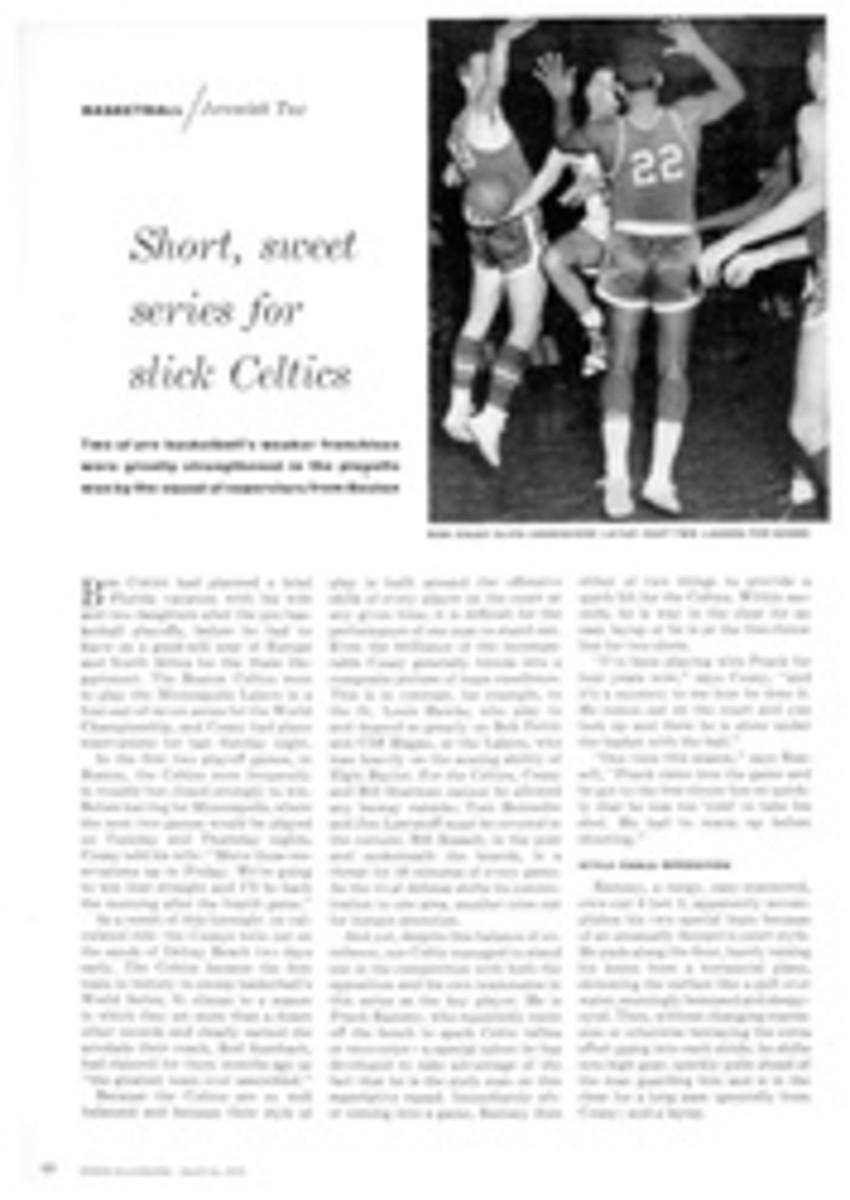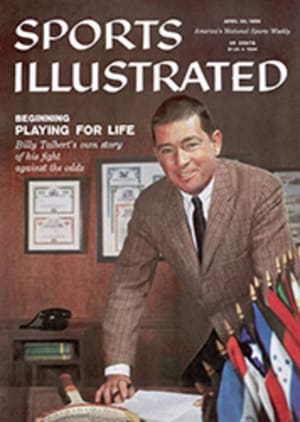
A pass in time
The lean, dark youngster bounced gently up and down on the track, shaking his hands loosely to relax his arm and chest muscles. He looked back across the curve of the track to the start of the 440-yard relay, his face intent and concentrated. As the runners across the field crouched to await the starter's gun, he took his position just inside the white mark in his lane which marked the beginning of the exchange zone. When the gun cracked he crouched slightly, in a sprinter's starting stance except that his hands were on his knees rather than on the track.
As the field rounded the curve, their speed exaggerated by the bend of the track, he looked steadily back over his right shoulder at the first runner for the University of Texas team, and as that first man hit a mark some 21 feet from the exchange zone, Eddie Southern took off. He did not look back again, but as he neared the line indicating the end of the exchange zone he dropped his right hand—palm to the rear, fingers extended together, thumb out—and held it there until he felt the baton slap up between his thumb and forefinger, then, changing the baton from his right to his left hand, he fled down the backstretch. Texas, traditionally a producer of fine teams, won the event, one of the features of the Texas Relays two weeks ago, in 40.4 seconds, 7/10 of a second off the world record for this race. The baton exchange between Wally Wilson, who ran the opening leg for Texas, and Southern had been beautifully smooth, and the baton changed hands with both runners at very nearly top speed.
"It was a good exchange," Southern said later. "Good, but not excellent."
Such insistence on perfection is characteristic of the outdoor track season in the United States, when relay races take an increasingly important part in track meets. The big relay carnivals—such as the Texas, Kansas and Drake in the Midwest—will be followed by a spate of meets in California, leading up to the National Championships in June and, this year, to the climactic United States-Russian dual meet in Philadelphia in July and the late-summer Pan-American Games in Chicago. But the competition preceding those big summer events is concentrated almost exclusively on relay races, with the individual events taking second place in interest to this great team effort of track and field sports.
Probably the best relay coach in the United States is a balding, pleasant young man named Oliver Jackson, who coaches the Abilene Christian College track team. His 440-and 880-yard teams last year set world records in their events, and in the race the University of Texas won at the Texas Relays a couple of weeks ago, an Abilene Christian team made up of three sophomores and a junior placed third and failed to press the winner only because of a bad baton pass.
Their failure can be ascribed to their youth. "It takes at least a year for a relay team to begin to operate perfectly as a unit," Jackson said earlier. "The team we had that set the 440 world record—Waymond Griggs, Bill Woodhouse, James Segrest and Bobby Morrow—was the best I have ever seen. They had a professional polish in their exchanges, and I say that not because I coached them. They worked together a long time and they made their baton exchanges perfectly, and, as individuals, they fit perfectly into a relay team."
Aside from the essential speed which is needed for the four men who make up a relay team, the most important factor in producing world records is the baton exchange.
"The time difference in a race in which your team makes three good exchanges and in a race in which it makes three excellent exchanges can be as much as a second and a half," Jackson said. "Mind you, that's the difference between good and excellent. We work on exchanges three times a week at half, two-thirds and full speed. We work on it until the boys react instinctively in the exchange zone and can devote all their concentration to running, not taking or giving the baton."
Jackson trains his teams to make the baton exchange in the last couple of yards of the 20-yard exchange zone, with both runners going at top speed. To insure this, he determines in practice how soon the outgoing runner should start in relation to the speed of the runner approaching him. Then he marks a take-off point on the track from 21 to 24 feet before the exchange zone begins, and he marks another point—a "lean" point—from 34 to 37 feet before the zone.
"The lean point is something we worked out a few years ago to give our outgoing runners the equivalent of a rolling start," Jackson explained. "If the outgoing runner stands flat-footed until the incoming man reaches the take-off point, he has a hard time reaching top speed in the 20 yards of the exchange zone. But if he begins to lean forward when his man hits the lean point, his body weight is ahead of his feet, just as it is in a regular sprinter's start, and he can drive and accelerate nearly as fast as he can off the starting blocks."
The baton exchange is made from the left hand to the right, and the outgoing runner never looks back once he starts. He takes the inside third of the lane and the runner coming up takes the outside, shouting instructions as he comes up so that he will not overrun his teammate or be left too far behind to make the exchange in the zone.
"The world record team was ideal in personnel, too," Jackson said. "You find out that kids who tense up too much in individual competition very often make good relay runners because they feel that they're getting help. Everything doesn't depend on them. So they gain confidence, and sometimes a kid who has fine essential speed but who can't relax in individual competition learns to relax running relays. One of the kids on this year's team is jittery, but he'll probably get over that after a year or so.
"But to get back to ideal personnel. Obviously, you need your best starter—not your best sprinter—on the first leg. We try to put our second-fastest man on the next leg—a guy like Bill Woodhouse, who was a great sprinter overshadowed by Morrow. That's for the psychological effect. You come blowing in there for the second exchange with a healthy lead, and you make the other teams nervous and sometimes they'll blow the exchange. We figure that exchange—between the second and third runners—is the most important, and we like to put pressure on the other teams there. The third guy should be a calm, unexcitable boy. Segrest was perfect. He had a wonderful sense of rhythm. His timing on the exchange was the best I have ever seen. And he was a fine sprinter, too. The anchor man should be your fastest man and your best competitor, and we had Bobby Morrow."
A BAD EXCHANGE
Jackson's current sprint relay team blew the second exchange sadly in the Texas Relays. Calvin Cooley nearly slipped to his knees as he took off, and the incoming runner overran him (see picture on page 63) and had to slow up and make the exchange at half speed. Still, the youngsters managed a 41.3, exceptionally good for so young a team.
Eddie Southern, Texas' fine sprinter and quarter-miler, ran the second leg for his team for the reason Jackson pointed out. A veteran of the Olympics, Southern gave Texas a wide lead going into the second exchange, which helped hurry the other teams into something less than excellent baton passes.
Jackson's relay technique is fairly standard now, although there is one iconoclast among his rivals. Johnny Morriss, the voluble University of Houston coach, searching for an edge to make up for the lack of essential speed, stations his outgoing runner on the two "curve" legs in the outer third of the lane so that he can cut from the outside of his lane to the inside, thus flattening the curve. His runners alternate passes from left hand to right, and the pass is made from the top down instead of upward. The outgoing runner holds his hand back with the wrist turned toward the body, palm out, and he does not transfer the baton from right or left hand.
"I got to cut all the corners I can," Morriss says. "I don't get the boys. But there's really no substitute for speed."
PHOTO
RARE BAD PASS slows this Abilene Christian College team, costing yards in the first exchange, as the incoming runner (14) overruns teammate, slows to give him baton. Calvin Cooley, taking delayed pass, slipped as he started. In background, rival team makes up valuable yardage with a nearly perfect pass near end of the zone.
DIAGRAM
IDEAL BATON EXCHANGE has incoming runner (light jersey) hand off baton to teammate in last two yards of 20-yard exchange zone. As incoming runner reaches point A, outgoing runner is crouched, watching teammate. As incoming runner passes point B, the outgoing runner leans in preparation for fast start. As he passes point C, the outgoing runner takes off and incoming runner overtakes him between point X and the end of the exchange area. The pass is made with both runners at top speed.
A
C
B
A
C
B
60 FT.
39 FT.
21-24 FT.
13-16 FT.

